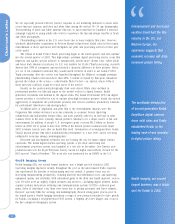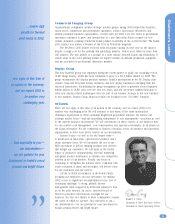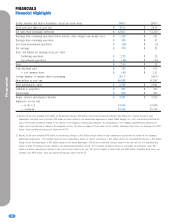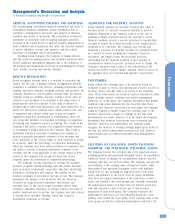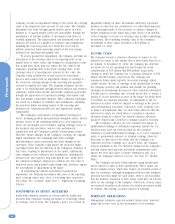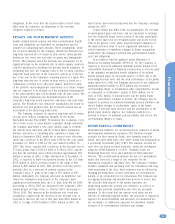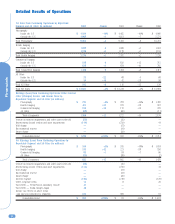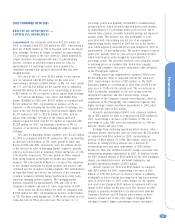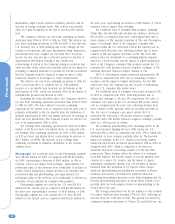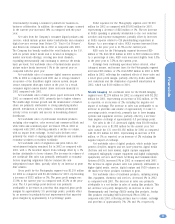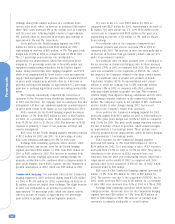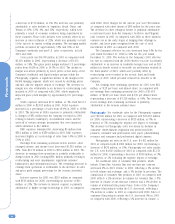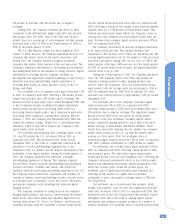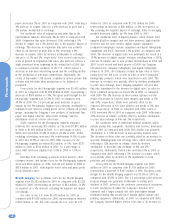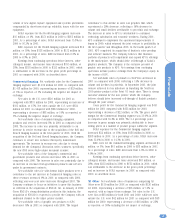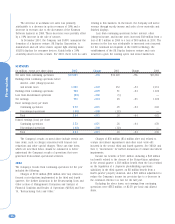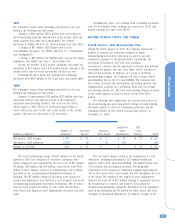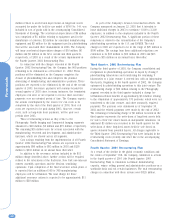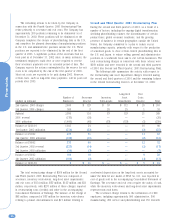Kodak 2002 Annual Report Download - page 14
Download and view the complete annual report
Please find page 14 of the 2002 Kodak annual report below. You can navigate through the pages in the report by either clicking on the pages listed below, or by using the keyword search tool below to find specific information within the annual report.
Financials
14
Although analog film volumes declined on a worldwide basis,
current sales levels reflect an increase in traditional film market
share. M&O sales increased 6% in the current year as compared
with the prior year, reflecting higher volumes of approximately
8%, partially offset by decreases in price/mix and exchange of
approximately 1% and 1%, respectively.
Gross profit for the Health Imaging segment was $930
million for 2002 as compared with $869 million for 2001,
representing an increase of $61 million, or 7%. The gross profit
margin was 40.9% in 2002 as compared with 38.4% in 2001.
The 2.5 percentage point increase was attributable to
productivity/cost improvements, which increased gross profit
margins by 2.9 percentage points due to favorable media and
equipment manufacturing productivity led by DryView digital
media, analog medical film, laser imaging equipment, and PACS,
which were complemented by lower service costs and improved
supply chain management. The positive effects of productivity/cost
on gross profit margins were partially offset by a decrease in
price/mix that impacted margins by approximately 0.5 percentage
point due to declining digital laser media and analog medical film
prices.
The Company substantially completed the conversion of
customers to the Novation Group Purchasing Organization (GPO)
in 2001 and, therefore, the Company does not anticipate that this
arrangement will have any additional significant potential impacts
on gross profit trends in the future as was experienced in 2001.
SG&A expenses for the Health Imaging segment decreased
$20 million, or 5%, from $367 million for 2001 to $347 million
for 2002. As a percentage of sales, SG&A expenses decreased
from 16.2% for 2001 to 15.3% for 2002. The decrease in SG&A
expenses is primarily a result of cost reduction activities and
expense management.
R&D costs for the Health Imaging segment remained constant
at $152 million for 2002 and 2001. As a percentage of sales,
R&D costs remained unchanged at 6.7% for both years.
Earnings from continuing operations before interest, other
(charges) income, and income taxes for the Health Imaging
segment increased $108 million, or 33%, from $323 million for
2001 to $431 million for 2002. The increase in earnings from
operations and the resulting operational earnings margin are
primarily attributable to the combined effects of improvements in
gross profit margins, lower SG&A expense, and the elimination of
goodwill amortization in 2002, which was $28 million in 2001.
Commercial Imaging Net worldwide sales for the Commercial
Imaging segment for 2002 increased slightly from $1,454 million
for 2001 to $1,456 million for 2002, representing an increase of
$2 million, with no net impact from exchange. The slight increase
in sales was attributable to an increase in price/mix of
approximately 1.0 percentage point, which was almost entirely
offset by declines in volume of approximately 0.9 percentage
point related to graphic arts and micrographic products.
Net sales in the U.S. were $818 million for 2002 as
compared with $820 million for 2001, representing a decrease of
$2 million. Net sales outside the U.S. were $638 million in the
current year as compared with $634 million in the prior year,
representing an increase of $4 million, or 1%, with no impact
from exchange.
Net worldwide sales of the Company’s commercial and
government products and services increased 7% in 2002 as
compared with 2001. The increase in sales was principally due to
an increase in revenues from government products and services
under its government contracts.
Net worldwide sales for inkjet products were a contributor to
the net increase in Commercial Imaging sales as these revenues
increased 175% in 2002 as compared with 2001. The increase in
sales was attributable to the acquisition of ENCAD, Inc., which
has improved the Company’s channel to the inkjet printer market.
Net worldwide sales of graphic arts products to Kodak
Polychrome Graphics (KPG), an unconsolidated joint venture
affiliate in which the Company has a 50% ownership interest,
decreased 10% in 2002 as compared with 2001, primarily
reflecting volume declines in graphic arts film. This reduction
resulted largely from digital technology substitution and the effect
of continuing economic weakness in the commercial printing
market. The Company’s equity in the earnings of KPG contributed
positive results to other charges during 2002, but was not
material to the Company’s results from operations.
Gross profit for the Commercial Imaging segment for 2002
decreased slightly from $451 million for 2001 to $449 million for
2002. The gross profit margin was 30.8% for 2002 as compared
with 31.0% for 2001. The gross profit margin remained relatively
flat due to declines related to price/mix, which reduced margins
by approximately 1.9 percentage points. These declines were
offset by productivity/cost improvements, which increased margins
by approximately 1.9 percentage points.
SG&A expenses for the Commercial Imaging segment
decreased $14 million, or 7%, from $208 million for 2001 to
$194 million for 2002. As a percentage of sales, SG&A expenses
decreased from 14.3% for 2001 to 13.3% for 2002. The primary
contributors to the decrease in SG&A expenses were cost
reductions from the prior year restructuring actions, which had a
larger impact on the results of 2002 as compared with 2001,
partially offset by the acquisition of ENCAD, Inc. in 2002, which
increased SG&A by $23 million.
R&D costs for the Commercial Imaging segment increased $5
million, or 9%, from $58 million for 2001 to $63 million for
2002. The increase was due to the acquisition of ENCAD, Inc. in
2002, which increased R&D costs by $8 million. As a percentage
of sales, R&D costs increased from 4.0% in 2001 to 4.3% in 2002.
Earnings from continuing operations before interest, other
(charges) income, and income taxes for the Commercial Imaging
segment increased $20 million, or 12%, from $172 million in
2001 to $192 million in 2002. The increase in earnings from
operations is primarily attributable to overall expense


